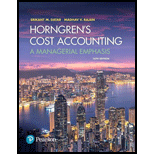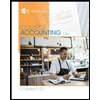
Horngren's Cost Accounting: A Managerial Emphasis (16th Edition)
16th Edition
ISBN: 9780134475585
Author: Srikant M. Datar, Madhav V. Rajan
Publisher: PEARSON
expand_more
expand_more
format_list_bulleted
Concept explainers
Textbook Question
Chapter 7, Problem 7.31E
Expert Solution & Answer
Learn your wayIncludes step-by-step video

schedule05:21
Students have asked these similar questions
[The following information applies to the questions displayed below.]
The following information is available for ADT Company, which produces special-order security products and uses
a job order costing system. Overhead is applied using a predetermined overhead rate of 55% of direct labor cost.
Inventories
Raw materials
Work in process
Finished goods
Beginning of
period
$ 48,000
9,000
65,000
Cost incurred for the period
Raw materials purchases
Factory payroll
Factory overhead (actual)
Indirect materials used
Indirect labor used
Other overhead costs
End of
Period
$ 43,000
20,700
34,900
$ 179,000
250,000
12,000
57,500
114,500
Exercise 16-44 (Algo) (Appendix used in requirement [b]) Variable Cost Variances (LO 16-5, 7)
Rankin Fabrication reports the following information with respect to its direct materials:
Actual quantities of direct materials used
Actual costs of direct materials used.
Standard price per unit of direct materials.
Flexible budget for direct materials.
Rankin Fabrication holds no materials inventories.
35,500 gallons
$ 201,680
$ 5.79
$ 213,100
Required:
a. Compute the direct material price and efficiency variances.
b. (Appendix) Prepare the journal entries to record the purchase and use of the direct materials using standard costing.
Direct materials price variance
Direct materials efficiency variance
Complete this question by entering your answers in the tabs below.
Required A Required B
Compute the direct material price and efficiency variances.
Note: Indicate the effect of each variance by selecting "F" for favorable, or "U" for unfavorable. If there is no effect, do not
select either…
!
Required information
[The following information applies to the questions displayed below.]
Clopack Company manufactures one product that goes through one processing department called Mixing. All raw
materials are introduced at the start of work in the Mixing Department. The company uses the weighted-average method
of process costing. Its Work in Process T-account for the Mixing Department for June follows (all forthcoming questions
pertain to June):
June 1 balance
Materials
Direct labor
Overhead
June 30 balance
Debit
Work in Process-Mixing Department
View transaction list
Credit
27,000 Completed and transferred to
Finished Goods
151, 100
95,500
113,000
The June 1 work in process inventory consisted of 4,400 units with $14,100 in materials cost and $12,900 in conversion
cost. The June 1 work in process inventory was 100% complete with respect to materials and 60% complete with respect
to conversion. During June, 36,900 units were started into production. The June 30 work in process…
Chapter 7 Solutions
Horngren's Cost Accounting: A Managerial Emphasis (16th Edition)
Ch. 7 - What is the relationship between management by...Ch. 7 - What are two possible sources of information a...Ch. 7 - Distinguish between a favorable variance and an...Ch. 7 - What is the key difference between a static budget...Ch. 7 - Why might managers find a flexible-budget analysis...Ch. 7 - Describe the steps in developing a flexible...Ch. 7 - List four reasons for using standard costs.Ch. 7 - How might a manager gain insight into the causes...Ch. 7 - List three causes of a favorable direct materials...Ch. 7 - Describe three reasons for an unfavorable direct...
Ch. 7 - How does variance analysis help in continuous...Ch. 7 - Why might an analyst examining variances in the...Ch. 7 - Prob. 7.13QCh. 7 - When inputs are substitutable, how can the direct...Ch. 7 - Benchmarking against other companies enables a...Ch. 7 - Metal Shelf Companys standard cost for raw...Ch. 7 - All of the following statements regarding...Ch. 7 - Amalgamated Manipulation Manufacturings (AMM)...Ch. 7 - Atlantic Company has a manufacturing facility in...Ch. 7 - Basix Inc. calculates direct manufacturing labor...Ch. 7 - Flexible budget. Sweeney Enterprises manufactures...Ch. 7 - Flexible budget. Bryant Companys budgeted prices...Ch. 7 - Flexible-budget preparation and analysis. Bank...Ch. 7 - Flexible budget, working backward. The Clarkson...Ch. 7 - Flexible-budget and sales volume variances....Ch. 7 - Price and efficiency variances. Sunshine Foods...Ch. 7 - Materials and manufacturing labor variances....Ch. 7 - Direct materials and direct manufacturing labor...Ch. 7 - Price and efficiency variances, journal entries....Ch. 7 - Materials and manufacturing labor variances,...Ch. 7 - Journal entries and T-accounts (continuation of...Ch. 7 - Price and efficiency variances, benchmarking....Ch. 7 - Static and flexible budgets, service sector....Ch. 7 - Flexible budget, direct materials, and direct...Ch. 7 - Variance analysis, nonmanufacturing setting. Joyce...Ch. 7 - Comprehensive variance analysis review. Ellis...Ch. 7 - Possible causes for price and efficiency...Ch. 7 - Material-cost variances, use of variances for...Ch. 7 - Direct manufacturing labor and direct materials...Ch. 7 - Direct materials efficiency, mix, and yield...Ch. 7 - Direct materials and manufacturing labor...Ch. 7 - Direct materials and manufacturing labor...Ch. 7 - Use of materials and manufacturing labor variances...Ch. 7 - Direct manufacturing labor variances: price,...Ch. 7 - Direct-cost and selling price variances. MicroDisk...Ch. 7 - Variances in the service sector. Derek Wilson...Ch. 7 - Prob. 7.47P
Additional Business Textbook Solutions
Find more solutions based on key concepts
Sykes Corporations comparative balance sheets at December 31, Year 2 and Year 1, reported accumulated depreciat...
Intermediate Accounting (2nd Edition)
Loder Company had a good year, and recorded a large gain on the sale of a discontinued business segment. Bates ...
Financial Accounting
Depreciation Methods, Disposal. Kurtis Koal Company, Inc. purchased a new mining machine at a total cost of 900...
Intermediate Accounting
Trend percentages and return on assets (Learning Objective 2) 20-25 min. Net sales, net income, and total asset...
Financial Accounting, Student Value Edition (5th Edition)
5. Which inventory costing method results in the lowest net income during a period of rising inventory costs?
W...
Horngren's Financial & Managerial Accounting, The Financial Chapters (Book & Access Card)
Quick ratio and current ratio (Learning Objective 7) 1520 min. Consider the following data COMPANY A B C D Cash...
Financial Accounting, Student Value Edition (4th Edition)
Knowledge Booster
Learn more about
Need a deep-dive on the concept behind this application? Look no further. Learn more about this topic, accounting and related others by exploring similar questions and additional content below.Similar questions
- For the accounting memo, you have to write THE CONCEPT of relevant cost. DON'T INCLUDE ANYTHING IRRELEVANT and PLEASE ANSWER THIS WITH 5 paragraphs.arrow_forwardes Required information [The following information applies to the questions displayed below.] Bunnell Corporation is a manufacturer that uses job-order costing. On January 1, the company's inventory balances were as follows: Raw materials Work in process Finished goods $ 50,000 $ 30,800 $ 43,200 The company applies overhead cost to jobs on the basis of direct labor-hours. For the current year, the company's predetermined overhead rate of $12.00 per direct labor-hour was based on a cost formula that estimated $480,000 of total manufacturing overhead for an estimated activity level of 40,000 direct labor-hours. The following transactions were recorded for the year: a. Raw materials were purchased on account, $696,000. b. Raw materials used in production, $655,400. All of of the raw materials were used as direct materials. c. The following costs were accrued for employee services: direct labor, $430,000, indirect labor, $150,000; selling and administrative salaries, $251,000. d. Incurred…arrow_forwardHello Please provide the journal entry for I.arrow_forward
- Please help mearrow_forwardPlease do not give solution in image format thankuarrow_forwardPost the appropriate entries to T accounts for Work in Process and Finished Goods, using the identifying letters as transaction codes. Determine the correct ending balance. The ending balance label is provided on the left side of the T account even when the ending balance is a credit. Work in Process b. 56,570 f. 39,200 e. 19,760 Bal. 37,130 ??? Finished Goods e. 39,200 g. 28,810 Bal. 10,390 ??? The T-Accounts are based on these journal entries. a. Materials 33,100 Accounts Payable 33,100 b. Work in Process 56,570 Factory Overhead 5,720 Materials 29,840 Wages Payable 32,450 c. Factory Overhead 6,470 Accounts Payable 6,470 d. Factory Overhead 1,790 Accumulated Depreciation 1,790 e. Work in Process 19,760 Factory Overhead…arrow_forward
- Required information The Foundational 15 (Static) [LO4-1, LO4-2, LO4-3, LO4-4, LO4-5] [The following information applies to the questions displayed below.] Clopack Company manufactures one product that goes through one processing department called Mixing. All raw materials are introduced at the start of work in the Mixing Department. The company uses the weighted-average method of process costing. Its Work in Process T-account for the Mixing Department for June follows (all forthcoming questions pertain to June): Work in Process-Mixing Department 28,000 120,000 79,500 97,000 Completed and transferred to Finished Goods June 1 balance Materials Direct labor Overhead June 30 balance The June 1 work in process inventory consisted of 5,000 units with $16,000 in materials cost and $12,000 in conversion cost. The June 1 work in process inventory was 100% complete with respect to materials and 50% complete with respect to conversion. During June, 37,500 units were started into production. The…arrow_forwardPlease help me with all answers thankuarrow_forwardplease help with d,e,f,garrow_forward
- Required information Use the following information to answer questions. (Algo) [The following information applies to the questions displayed below.] The following information is available for ADT Company, which produces special-order security uses a job order costing system. Overhead is applied using a predetermined overhead rate of 5 labor cost. Beginning of period $ 45,000 9,600 68,000 End of Period $ 45,000 19,000 33,500 Inventories Raw materials Work in process Finished goods Cost incurred for the period Raw materials purchases Factory payroll Factory overhead (actual) Indirect materials used Indirect labor used Other overhead costs $ 178,000 250,000 9,000 57,500 115,500 Exercise 15-15 (Algo) Recording actual and applied overhead LO P3 1. Incurred other actual overhead costs (all paid in Cash). 2. Applied overhead to work in process. Prepare journal entries for the above transactions for the period. View transaction list Journal entry worksheet A В Record the entry for other actual…arrow_forwardDon't give answer in image formatarrow_forwardPrepare journal entries and calculate net payarrow_forward
arrow_back_ios
SEE MORE QUESTIONS
arrow_forward_ios
Recommended textbooks for you
 College Accounting, Chapters 1-27AccountingISBN:9781337794756Author:HEINTZ, James A.Publisher:Cengage Learning,Principles of Accounting Volume 1AccountingISBN:9781947172685Author:OpenStaxPublisher:OpenStax College
College Accounting, Chapters 1-27AccountingISBN:9781337794756Author:HEINTZ, James A.Publisher:Cengage Learning,Principles of Accounting Volume 1AccountingISBN:9781947172685Author:OpenStaxPublisher:OpenStax College

College Accounting, Chapters 1-27
Accounting
ISBN:9781337794756
Author:HEINTZ, James A.
Publisher:Cengage Learning,

Principles of Accounting Volume 1
Accounting
ISBN:9781947172685
Author:OpenStax
Publisher:OpenStax College
Cost Accounting - Definition, Purpose, Types, How it Works?; Author: WallStreetMojo;https://www.youtube.com/watch?v=AwrwUf8vYEY;License: Standard YouTube License, CC-BY